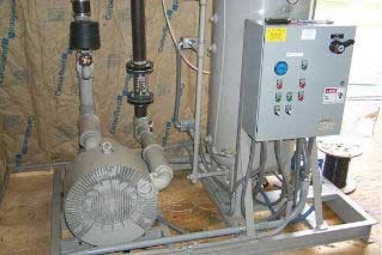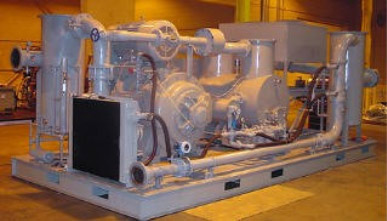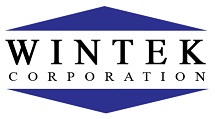
ACFM @ 15″HgV Regenerative SVE
Soil Vapor Extraction (SVE)
Soil vapor extraction is a general term for pulling a vacuum on contaminated soils to remove volatile organic compounds (VOCs). The process has several different names including: High Vacuum SVE, Multi-Phase, Dual Phase, 2-Phase™. The choice of vacuum pump offered depends upon a number of factors, which include the vacuum level, desired reliability, and cost.
Straight “SVE”
Straight SVE only pulls vapors from the vapor zone above the water table. Typical systems include an inexpensive entrainment tank and filter before the vacuum pump. Since water carryover is not anticipated, there is usually no allowance for water accumulation. The standard pump used in this range is a regenerative blower.

3000 cfm @ 26″HgV oil-sealed Dual Phase SVE system with inlet Knock-Out Pot and Integrated Humidity Control
High Vacuum SVE, Multiphase SVE, Dual Phase SVE, and 2-Phase™
These types of soil vapor extraction designs include groundwater entrainment carryover with the vapor flow. Additionally, these systems will include inlet knockout pots and water transfer pumps. Often, the purpose of pulling the higher vacuum on the soil is to increase the water yield from the well for treatment. Depending how tight the soil formation, however, high vacuum can increase the water yield by a factor of 10 times.
Vacuum levels for these designs are typically in the 10”HgV to 28”HgV range. In the 10” – 15”HgV range, you will typically see rotary lobe blowers and liquid ring vacuum systems (water and oil). However, in the 15-28”HgV range, you will almost exclusively find liquid ring vacuum system (water and oil) as the vacuum source. Capacities can range from 100 to 4,000 CFM.
Water-Sealed vs. Oil-Sealed Liquid Ring Vacuum Pumps
Wintek supplies both for soil vapor extraction applications. However, in terms of long term reliability, we recommend the oil-sealed version. Although it is not intuitive to use an oil-sealed pump on an environmental cleanup site, this design overcomes many of the problems encountered with water-sealed pumps. Although liquid ring pumps are rugged, the pumps also have drawbacks. The problem with water-sealed liquid ring pumps is the quality of the water (typically dirty and high in minerals – hard water) available at most sites.
The minerals tend to plate out on the pump internals, valves, and switches which causes system problems and down-time. These damages tend to start in the 2nd year of operation. Wintek’s oil-sealed liquid ring systems typically achieve 90-95% uptime over the 1st five years of operation, based on customer feedback.
Integrated Humidity Control Option for Soil Vapor Extraction Systems
This option may be desired when operating at vacuum levels in the 15”-28”HgV range, if you are utilizing vapor phase carbon on the system discharge. By nature of activated carbon, for optimal adsorption, the vapor stream to the carbon should be controlled in temperature and humidity at 50% RH and 90-110oF. High vapor temperatures and high humidity can impede adsorption of VOC’s on activated carbon, thus increasing a site’s on-going operating costs. Wintek’s Integrated Humidity Control System (US Patent 5,441,365) optimally conditions the vapors for carbon adsorption, thus keeping operating costs down.
2-Phase™ is a trademark of Xerox Corporation


